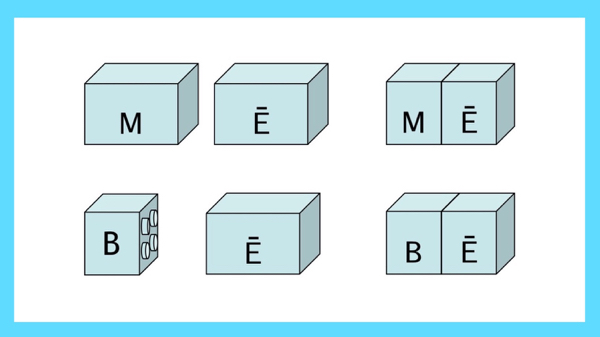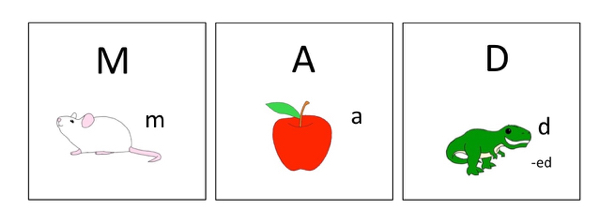 | |
Blending Words | ||
Blending seems easy to an adult reader. However, it is a skill that can be difficult for some children to learn. It also depends on phonemic awareness, the ability to hear and manipulate the sounds in words. This is not an innate skill, either. Brain studies have shown that adult illiterates do not have phonemic awareness until they are taught this skill as part of learning to read, showing brain changes after they learn these skills. [1] Links and books for developing and testing for phonemic awareness are shown in footnote [2] at the bottom of this page. Recent brain research has found that good readers process all the letters in words, just very fast in parallel. [3] More explanations about this and how and why sight words should not be taught by wholes, but instead should be taught phonetically, can be found on 40L’s sight word page. It is important to start good habits from the beginning, focusing on sounding out every letter in every word from left to right. Step 1. Oral Blending You should start with oral blending, pick some simple 2 letter words to start with, like on, up, me, no, go. Letter sounds are typically shown with slashes, so you would say: /o/ /n/ makes on. Start slow, then speed up. Make it a fun game, do a word here and there as you go, /g/ /o/, go! Step 2. Letter Sounds The easiest way to learn the basic letter sounds is with the Leapfrog DVD Talking Letter Factory, but you can also use other methods. It has over 2,000 reviews and 5 stars for a reason, that little frog is a master letter sound teacher, and he never tires of the repetition necessary to master the sounds. 40L’s vowel and consonant charts can be used while learning to blend and read words and are also helpful for learning letter sounds. Step 3. Blending Now, we can combine the knowledge from the first two stops to blend letters in written words. Again, start with 2 letter words, and, use the easiest letters to blend to start. The letters M, N, all vowels, and R and L at beginning of word are the easiest letters to blend. (After a vowel, the letters L and R will modify the sound of the vowel.) Explain blending by starting with the sounds stretched out, then “said faster.” A visual picture of this can be shown with a slinky or spring contracting and sounds getting shorter and “mushed together.” Allophones and Approximations Letter sounds said in isolation are not exact representations of how the sound when they are put together in words. In fact, there is a name for the different variations of how letter sounds are made, linguists call these different sounds “allophones.” The letter "t" will sound slightly different in the words "top" vs "stop" vs "at." The different sounds it makes are called allophones. Moreover, letter sounds in isolation are actually approximations, they will not exactly match their sound when put together in words. For example, you cannot say the sound of the letter b, /b/ in isolation. Even if you think you are, you cannot physically say it without a bit of a vowel sound, typically short u “uh” at the end of the letter. You may say the “uh” part very short in duration, but it is there even if you do not hear or feel yourself saying the “uh” sound at the end of /b/. So, when you blend b with a vowel, it is an approximate sound of b that is being blended and the vowel portion of b will be cut off and instead you will say the vowel that comes after the b. The blocks below are a visual representation of what is happening when you say this, the bumps on the block representing the vowel portion when you try to say a pure /b/ in isolation but say a bit of vowel at the end. When you put the sounds together in a word, the vowel part is removed just like the block's bumps are hidden when they are put together. | |
 | ||
The letters m and n can be extended without adding a vowel sound, but they are typically said for a longer length when said in isolation than when put together to make a word, the picture above shows what happens when /m/ and /e/ are blended together to make me. Fun Blending Ideas A fun way to learn to blend is to run a small toy race car or a small plastic animal over letters, blending each sound and then saying the word as the car or animal crosses each sound. You can use letters written on index cards or letter game tiles or magnetic letters, you can also use 40L’s letter cards, these cards spelling out the word "mad" are shown below. | |
 | ||
You can make page size letters, jump from letter to letter, say each sound, jump quicker and quicker and say sounds quicker and quicker to blend the word. You can also shoot foam darts at page size letters, etc. Blending may take time to learn Blending is a developmental skill that may take some time and explanation and modeling to click, if the skill is not clicking, go back to oral blending and work on spelling. Many children are able to spell simple short words before they are able to master the skill of blending. Spelling will help reinforce the left to right direction of reading and spelling. You can teach that “letter sounds are used to read a word, letter names to spell a word.” Syllables and 2 letter words are also easier to learn to blend than 3 letter words, you can work on the syllables in Webster’s Speller. Because letter sounds are actually letter sound approximations, or allophones, blending is harder to learn than spelling and is a developmental skill that takes both practice and understanding of how these approximations blend together to make a word. You can see more about letter sound approximations and pictures of sound waves on 40L’s dyslexia page. Some children pick up phonemic awareness and blending apparently out of the blue, but it is a skill that is not innate, some children can learn it from clues picked up from the phonetic nature of language and their observations of the language in their environment. Most children can learn to blend by age 5, and some children can learn to blend at age 3 or 4, but it may take a lot of practice and modeling and explanation even for a 5 or 6 year old. Phonics methods that make learning blending easier The “I See Sam” method focuses on left to right blending with a notched card, some of the original authors of the program have explanations about how and why to use this program. A study of this method found that it reduced illiteracy and was even more powerful for minority students, lower SES students, and students whose first language was not English. [4] You can also print the first 51 books used in the original study here. Blend Phonics is a free, good beginning phonics program that is available from Don Potter. Both the “I See Sam” and the Blend Phonics programs go up to 1st grade level, but are a very good foundation. Word Mastery is free, and goes up to a 3rd grade level. Word Mastery is a good program to use if your student is having trouble learning to blend because it starts with the easiest letters to blend. Webster’s Speller is good follow on. Webster’s Speller teaches phonics to the 12th grade level but a bit more work to use, see 40L's Webster page and 40L's YouTube multi-syllable phonics videos. You can use 40L’s vowel and consonant charts with any of these or any other good phonics program. To find a good basic phonics program, select one from 40L's phonics and spelling book page, Don Potter's reading page, or the National Right to Read Foundation's product resources page. Another good follow on to basic phonics are the free lessons on 40L's multi-syllable phonics page. Most importantly, for success teaching a student to blend and read, do not teach more than 5 sight words as wholes, you can find out why on 40L’s sight word page, and 40L's YouTube sight word videos. For more blending information, read the instructions in beginning of good phonics programs, watch 40L’s YouTube blending words video, and see information about reading on Don Potter’s reading instruction and research page. [1] Dehaene, Statislas, "Illiterate to Literate:behavioural and cerebral changes induced by reading acquisition," Nat Rev Neurosci, 16(4):234--244, April 2015. [2] A free phonemic awareness test is available from Spelfabet. It is called the Test of Auditory Analysis Skills, or TAAS. Students who have just a bit of a phonemic awareness problem can be helped with simple explanations of how speech sounds are made and how they combine, but more extensive remediation often requires a speech therapist. Several parents I have know have successfully done phonemic awareness remediation on their own with a program such as LiPS, Lindamood Phoneme Sequencing Program, but it requires a bit of study and work. A simple, easy to use book for a young student with just a bit of a phonemic awareness problem is "Phonemic Awareness in Young Children" by Marilyn Adams. A basic understanding of phonetics can be had from the online demonstrations or the phone apps from the University of Iowa's Sounds of Speech, some of 40L's students with underlying speech problems have found this website and app helpful. [3] Dehaene, Stanislas, "The Massive Impact of Literacy on the Brain and its Consequences for Education," Human Neuroplasticity and Education, 2011, p. 23 [Note: Stanislas Dehaene's 2009 book "Reading in the Brain" has a more detailed explanations and compares many different studies.] [4] Hanson, Ralph A and Farrell, Donna. "The Long-term effects on high school seniors of learning to read in kindergarten," Reading Research Quarterly, Vol. 30, No. 4. November/December 1995, International Reading Association. Available online at: http://www.3rsplus.com/documents/The_Long-term_Effects_000.pd | |